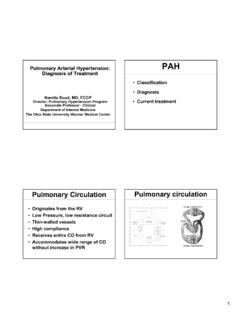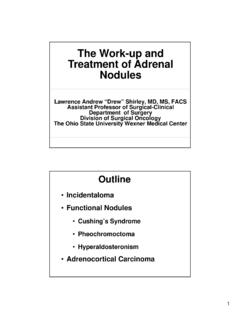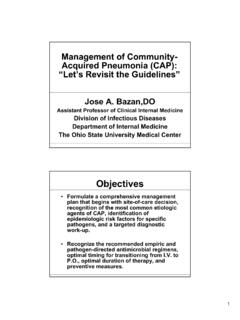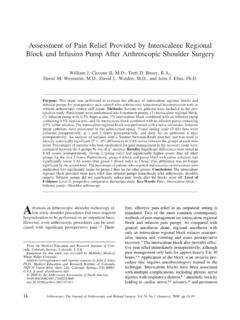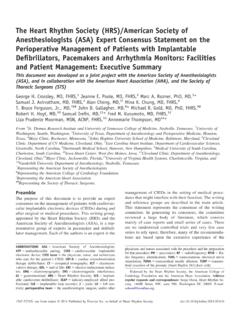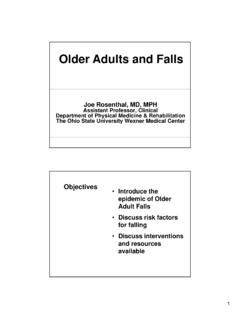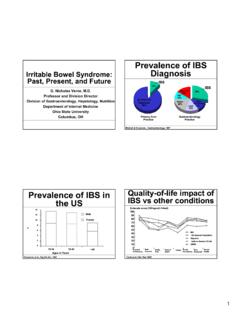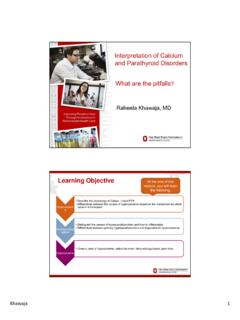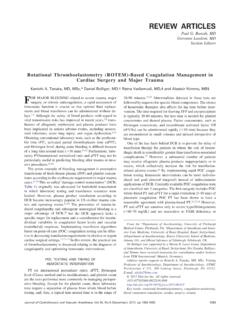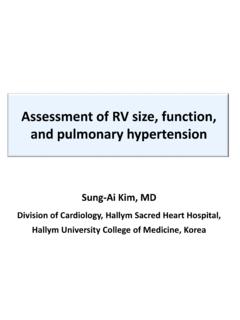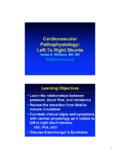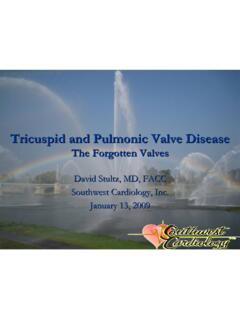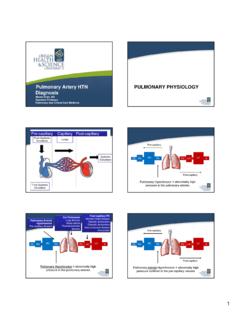Transcription of An Interatrial Shunt Device for Diastolic Heart Failure
1 5/18/20181An Interatrial Shunt Device for Diastolic Heart FailureRami Kahwash, MDAssociate Professor in Internal MedicineDivision of Cardiovascular MedicineSection of Heart Failure /TransplantDirector of The Cardiovascular Research Organization The Ohio State UniversityWexner Medical Center1 Objectives Review the incidence and demographics of Heart Failure with preserved Ejection Fraction (HFpEF) Understand the pathophysiology for HFpEF Review management of HFpEF Discuss the role of Left Atrial Pressure (LAP) in symptoms & prognosis of HFpEF Highlight future directions for management of HFpEF including Interatrial Shunt Device (IASD)25/18/20182 Definition HFpEF variably classified as EF >40%, >45%, >50% Syndrome of HFpEF: clinical signs or symptoms of HF evidence of preserved or normal LVEF evidence of abnormal LV Diastolic dysfunction by Doppler echocardiography or cardiac catheterization More challenging to diagnose than HFrEF largely diagnosis of exclusion3 Vasan RS, Levy D.
2 Circulation 2000 HFpEF: Increasing PrevalenceBy 2020, 65% of hospitalized HF pts will have EF > 40%By 2020, 65% of hospitalized HF pts will have EF > 40%GWTG - HF: N=110,621 patients hospitalized with HF; P< for trend of increased HFpEF prevalence(based on data from Steinberg et al. Circulation 2012)Oktay A, Shah SJ. Curr. Cardiol. Rev. 20135/18/20183 Heart Failure OutcomesOwan TE et al, NEJM. 20065-yr survival: HFrEF 65%, HFpEF 68%, (HR , p < )HFrEF: Survival increased over time (HR , p = )HFpEF: Survival did not change over time6 Borlaug BA, Redfield MM. Circulation 2011;123:2006-2014 HFpEF, Few Established Therapies5/18/20184 Management General Principles Impaired response to stress Atrial fibrillation: loss of atrial contraction reduces LV filling and stroke volume Tachycardia: shortens duration of diastole Elevated BP: increases ventricular wall stress worsening myocardial relaxation Acute ischemia worsens Diastolic function All may result in LVEDP, pulmonary congestion, or edema78 Yancy, et al.
3 JACC 2013 HFpEF, Few Established Therapies5/18/20185 Case Presentation78 Year-old woman referred for evaluation of progressive DOE PMH: HTN, DM II MEDs: Norvasc, HCTZ, metformin ECG: NSR, LVH by voltage criteria, LAE CXR and PFT: unremarkable Lab: BNP~ 80 Stress Echo: exercised 3 minutes and stopped due to SOB & fatigue. No stress induced WMA at HR achieved. Echo: mild LVH, normal LVEF, LAE, RVSP: 35 mm Hg LHC: mild plaque disease, LVEDP: 14 mm Hg RHC: RA: 8, PA: 34/13, PCWP: 15, CO/CI: 5 step: biopsy + Exercise her she does not have Heart Failure Lasix 20 mg daily and follow up in 3 monthsBorlaug et al. 2010; Circ Heart Fail 3 with exertional dyspnea, EF > 50%, n = 55-No significant coronary disease-Normal brain natriuretic peptide, resting hemodynamics -mPAP < 25 mm Hg; PCW < 15 mm Hg-Exercise PCW >25 occurred in 32/55-Greater increase in PCW-Tempered increases in HR, cardiac output-PASP > 45 mm Hg ~95% Sn and SpHeart Failure with Preserved Ejection Fraction5/18/20186 Dorfs et al.
4 , European Heart Journal (2014) 35, 3103 3112 Retrospective study, n = 355 with suspected HFpEFExercise PCW Pressure in HFpEFExercise CapacityRestRestExerciseExerciseRestExer cisePCWP > 12 PCWL > 25 Exercise Hemodynamics can identify HFpEF, correlate to exercise capacity, and are more predictive of mortalityThe magnitude of the exercise - mediated rise in PCWP in HFPEF is related to both symptoms and of Elevated LA Pressure in HFPEFSURVIVALD orfs EHJ 2014 SYMPTOMS01002003000200400600 Workload corrected PCWP (mmHg/W/kg)Six minute walk (m eters)r= < LAP-HF Unpublished data||||||||||||||2468 10 12 14 161009080706050 Work corrected PCWP> mmHg/W/kgWork corrected PCWP< mmHg/W/kgp= (%)5/18/20187 ENVIRONMENT, DIETCOMORBIDITIESGENETIC SUSCEPTIBILITY LA pressureHFpEFEXERCISE-INDUCEDDIASTOLIC DYSFUNCTIONVOLUME OVERLOADPULMONARY HTN,RV FAILURET hree types of HFpEF presentationShah SJ.
5 JACC 2013 HFpEF: A New ApproachL R Shunts may Reduce HF Symptoms Lutembacher syndrome described in 1916 ASD in the context of mitral stenosis1-4 MS patients with congenital ASD did better compared to MS w/o ASD1 Firket,1880; 2 Lutembacher, 1916; 3 Rosenthal,1956; 4 Espino-Vela, 1959; 5 Aldridge, to Right Shunts and Heart FailureEwert et al., 2001, CCI 52:177-80 Masked Left Ventricular Restriction in Elderly Patients with Atrial Septal Defects. 18 patients had LA pressures measured during balloon occlusionIn 7, LA pressure increased considerablyTwo of them proceeded with ASD closure and developed CHFCAUTION Investigational Device . Limited by Federal (or United States) law to investigational useInterAtrial Shunt Device - Mode of Action16 Elevated LV fillingpressures (Elevated LAP) pulmonary Venous hypertension pulmonary Congestion & Dyspnea (rest/exercise)Transcatheter Interatrial Shunt deviceIASD area of intervention5/18/20189 Corvia IASD System ComponentsCatheter2 Implant19mm OD 8 mm ASD1 Exclusively for Clinical Investigation.
6 CAUTION Investigational Device . Limited by Federal (or United States) law to investigational use; 2 16F introducer simulation demonstrated that an 8mm Interatrial Shunt Device (IASD ) would provide acute LA decompression during exerciseLeft Atrial Decompression: IASD RationaleLA pressureRA pressureKaye et al JCardFail 20145/18/20181019 REDUCE LAP-HF Trial Hasenfu G et al: Lancet 2016; 387: 1298 304 Inclusion Criteria (n=64): Open labelLVEF 40%, NYHA class II-IV Elevated PCWP 15 mmHg (rest) or 25 (supine bicycle exercise)Objectives: Device Safety: major adverse cardiac, cerebrovascular and systemic embolic events MACCE Device performance: L Rshunting(echocardiography) Clinical Benefits: clinical efficacy: NYHA class, quality of life (MLWHFQ), 6MW distance cardiac structure and function (echocardiography) rest and exercise hemodynamicsBaseline Characteristics (n=64) 20 Age (Y)69 8 Gender (% Female/Male)66 / 34 LVEF (%)47 7 NYHA Class (n, II/III/IV)18/46/0 Minnesota Living with HF Score49 20 BMI kg/m233 6 Permanent AF (%)36NT-Pro BNP (median, IQR )377 (222-925)Hypertension (%)81 Diabetes (%)33 Coronary artery disease (%)36 Diuretics at baseline (%)91 Resting CVP (mm Hg)9 4 Resting PCWP (mm Hg)17 55/18/201811 Safety (MACCE) and Device PerformanceMACCE eventSix months %One year % (3/64) (1/64)* (pt died) MI00 Systemic embolic event00 Implant removal 0021 Device patency confirmed in 54 subjects (by echo or oximetry)Safety (MACCE) and Device Performance22 Effectiveness Six months %One year %L R Shunt flow (Echo)
7 100 (49/49)100 (48/48)R L Shunt flow (Echo)00 patency confirmed in 54 subjects (by echo or oximetry)5/18/201812 Efficacy at 6 & 12 months(Patients with data at all 3 time points)0102030405060 Baseline 6M12 MMLWHFp < < 6M 12M6 Min Walking Distance (m)p = = 6M 12 MNYHA Classp < < at 1 year: 15 points82% improved > 5 pointMean at 1 year: 33m47% improved > 20mMean at 1 year: *improved I-II classes* Higher than at 6M: p = Hemodynamic Results (rest)24 Patients with data at all 3 time points. BaselineSix monthsOne yearRA pressure8 3 11 6 10 4PA meanpressure25 823 7 26 8 Wedge pressure19 616 8 17 ** ** p< vs baseline5/18/201813 Summary Implantation of an Interatrial Shunt Device appears to be safe with an acceptable MACCE rate through one year of follow-up Interatrial Shunt Device patency was maintained through one year The clinical and hemodynamic benefit observed 6 months after implant was sustained through one year, with no evidence of adverse sequelae Meaningful improvements in NHYA class, exercise capacity and QOL Clinically meaningful reduction in normalized PCWP25 REDUCE LAP-HF 1 (1stRANDOMIZED TRIAL) Multicenter, Prospective Randomized, Controlled, Patient Blinded Trial 1:1 randomization in the Cath.
8 Lab Non-implant Intra Cardiac Echo (ICE) Control group Patients will be followed for 1 year, and annually every 12-months for 4 years after index procedure and implant 40 subjects at up to 20 investigational sites in the ; and up to 5 investigational sites OUS. 1 month key outcome measure follow-up Safety PCWP change5/18/201814 REDUCE LAP-HF I (n=44)Randomized, controlled trial (1:1)NYHA III-IV, LVEF > 40%, HF Hosp or BNPPCW > 25 mm Hg (Exercise); PCW:RA > 5 mm HgIASDCONTROL30-d Hemodynamic Outcomes*No adverse events at 30-d follow up in treated armPhase IIFeldman et al., 2017 Circulation, AHA, in pressII. Devices and OutcomesFeldman, TCT 2017 Early clinical experience suggests IASD Implantation associated with No major Device -related complications Procedural success No change in resting PCWP Decrease in exercise associated PCWP Stable Shunt fraction ~ :1 up until 12-mos Improved 6-minute walk time, NYHA class, living-with- Heart Failure scoresCorvia Interatrial Shunt Device (IASD)5/18/201815II.
9 Devices and OutcomesFeldman, TCT 2017 Pilot study (n=11): non-randomized, single-arm Completed (S ndergaard L, et al. Eur J Heart Fail 2014); extended follow-up ongoing CE Mark Study (n=64): non-randomized, single-arm Completed (Hasenfu Lancet 2016; Kaye Circ. HF 2016 ); 2Y follow-up complete Q3 2017 REDUCE LAP-HF I (n=44): RCT mechanistic study FDA approved IDE; (enrollment complete); 1Y follow-up complete Dec 2017 REDUCE LAP-HF II (n=380): RCT pivotal study FDA approved IDE; recruiting HFrEF Feasibility study FDA approved IDE; recruiting REDUCE LAP-HF III (n=100): Post-market Registry Germany RecruitingCorvia Interatrial Shunt Device (IASD) StudiesII. Devices and Outcomes Recruitment EMR, cath lab database Clinics Research Coordinator Outreach Hemodynamics! Screen, screen, Shunt DeviceV-WaveAlthough strongest hemodynamic rationale is perhaps HFpEF, trials to date have included HFrEF and pulmonary hypertension.
10 Affects degree and direction of Shunt , different short-term goals, long-term ramifications. Strategies for LA DecompressionII. Devices and OutcomesWT Abraham, TCT 2017 Porcine pericardial leaflets improves flow mechanics prevents R to L shunting and paradoxical embolization Hourglass shape secure and atraumatic septal retention minimal ID mm orifice ePTFE encapsulation blocks tissue ingrowthRight AtriumLeft AtriumThe V-Wave Shunt DeviceNitinol frameInter-atrial septum Anticoagulation for 3 months14F delivery system 5/18/201817II. Devices and OutcomesGW Stone, TCT 2017*p < compared to baselineV-Wave Open-LabelN = 38, 30 HFrEF, 8 HFpEF, 12-mo Follow upFeasibility Devices that permit Interatrial flow are emerging for a range of conditions Early experience suggests improved hemodynamics and functional status Ongoing trials and surveillance Durability of functional improvement, Shunt Potential side effects Represent first Device based therapies for HFpEF34 Conclusions5/18/201818 THANK YOU
